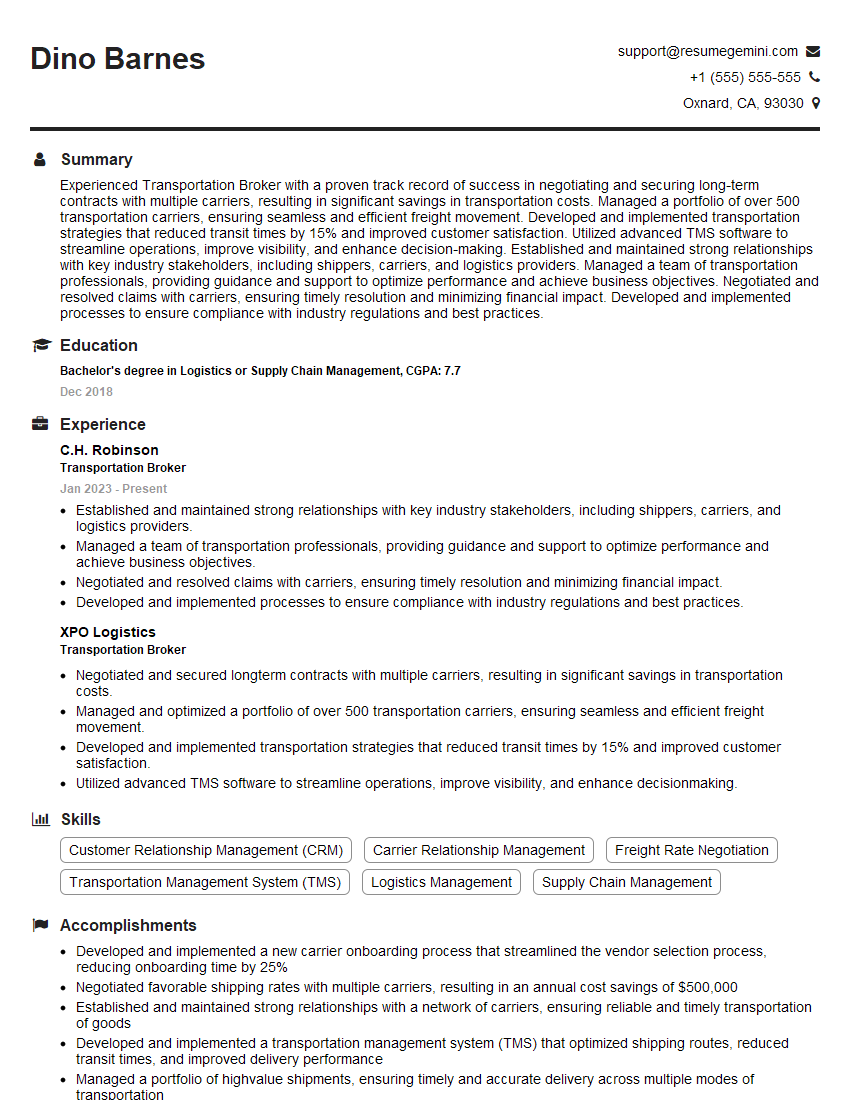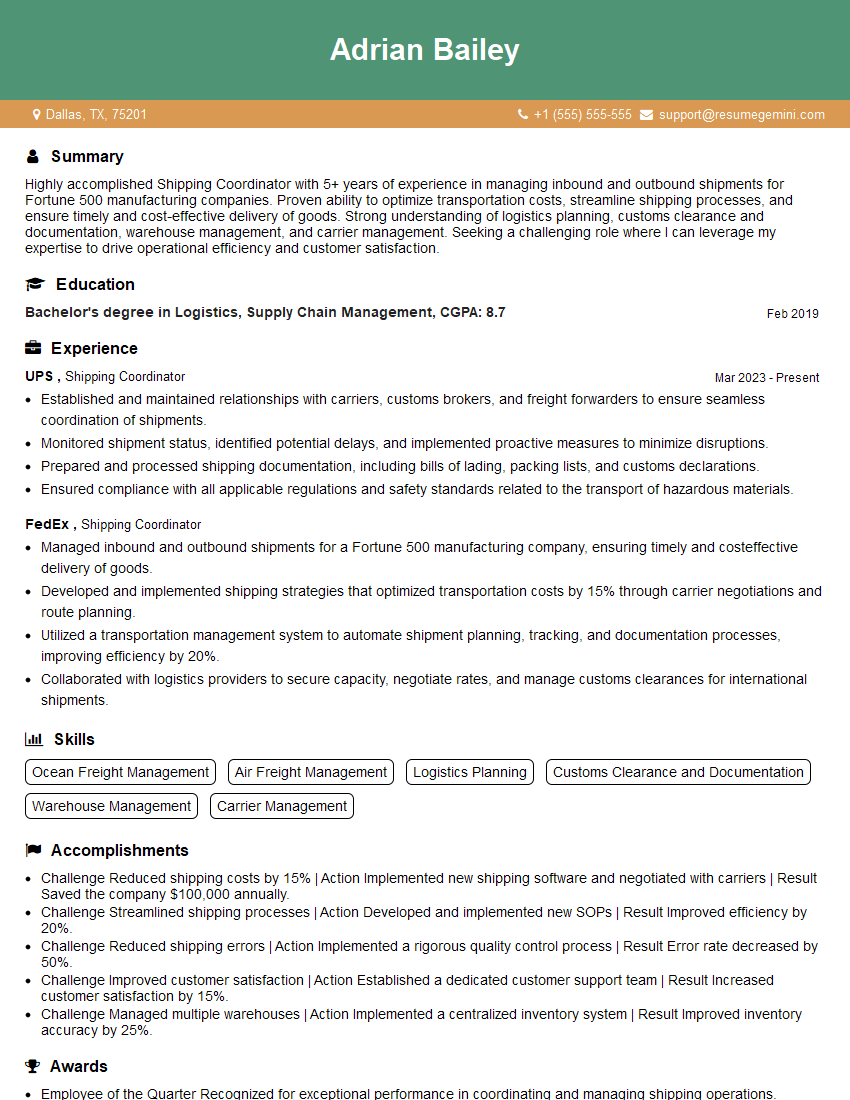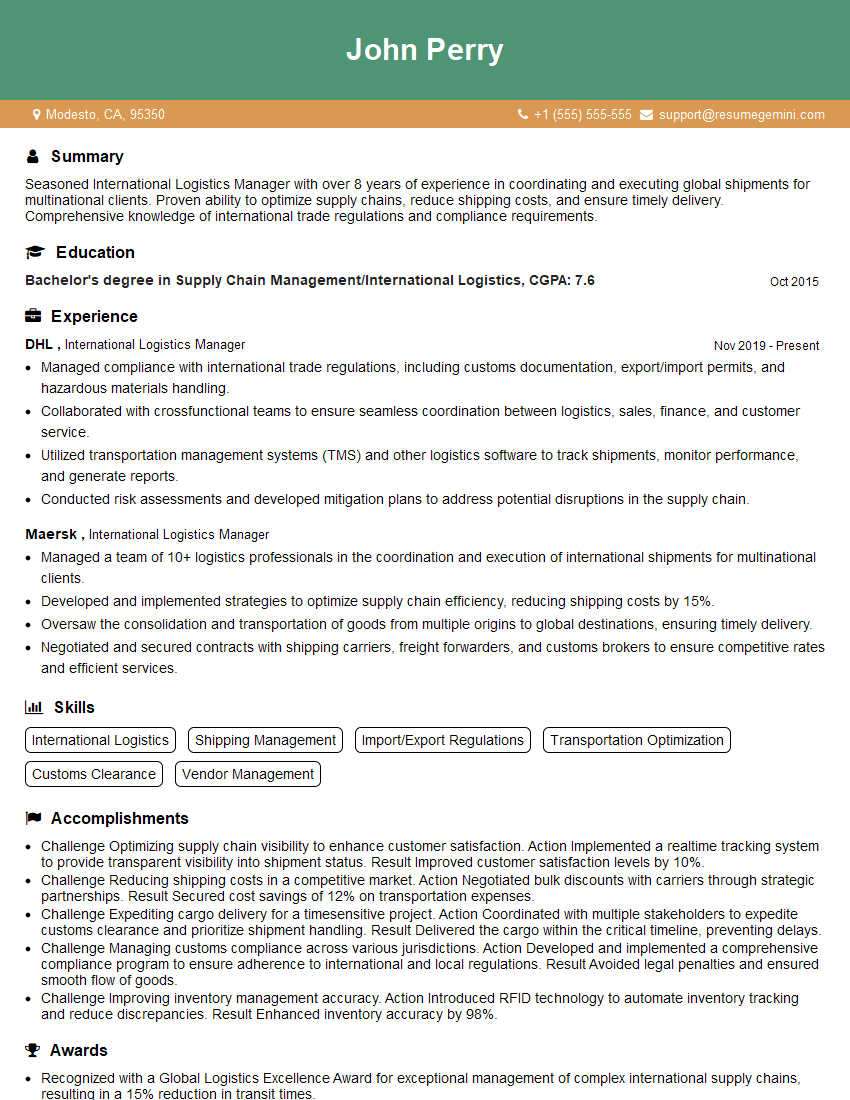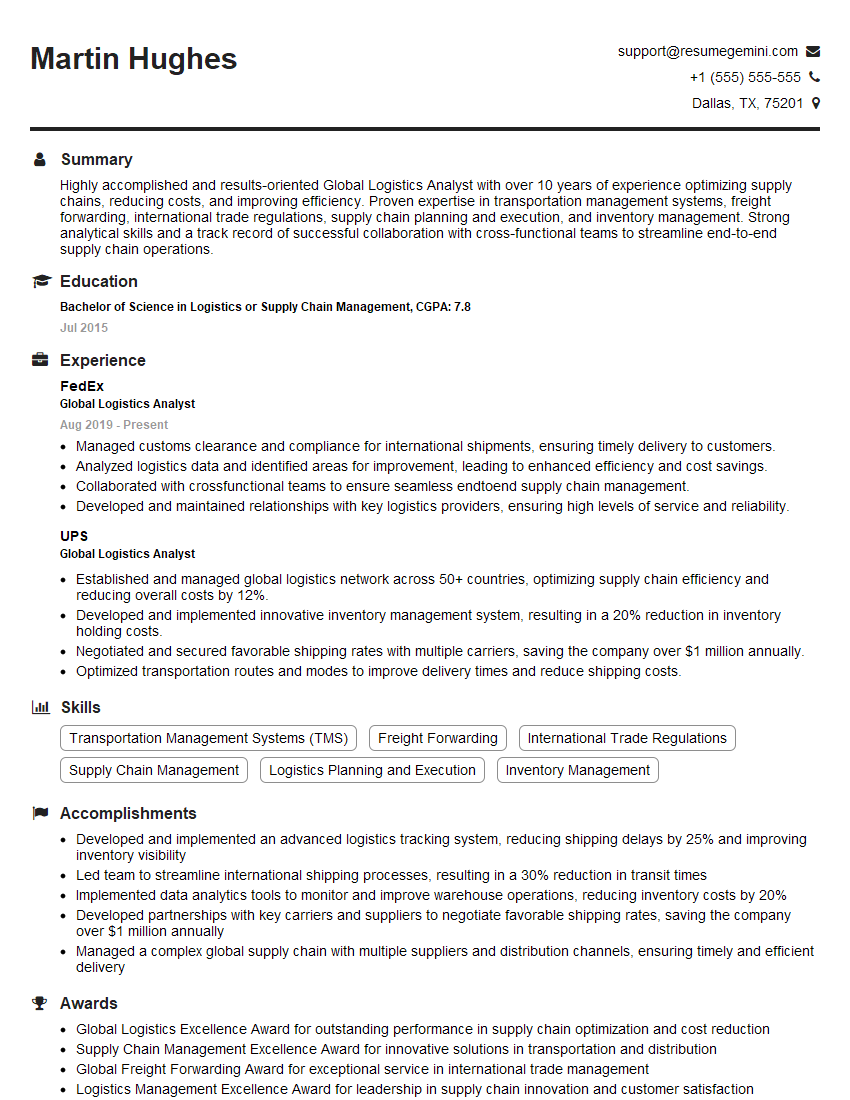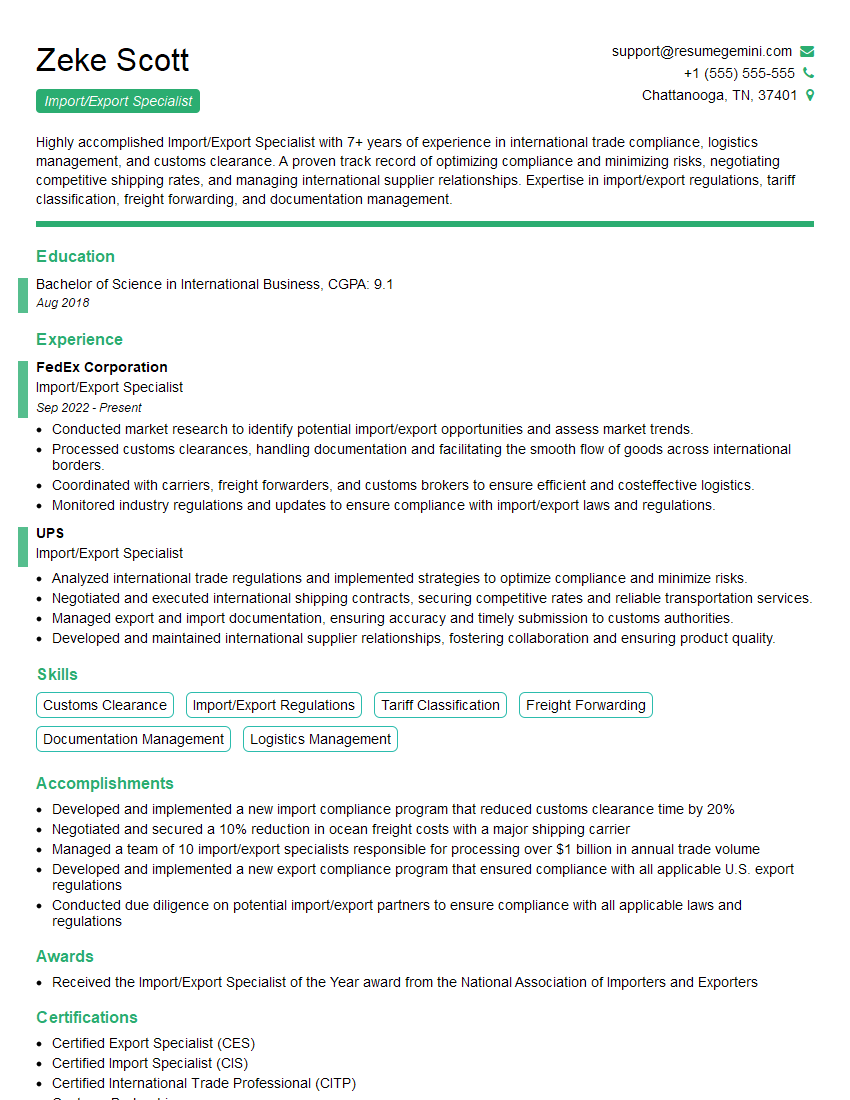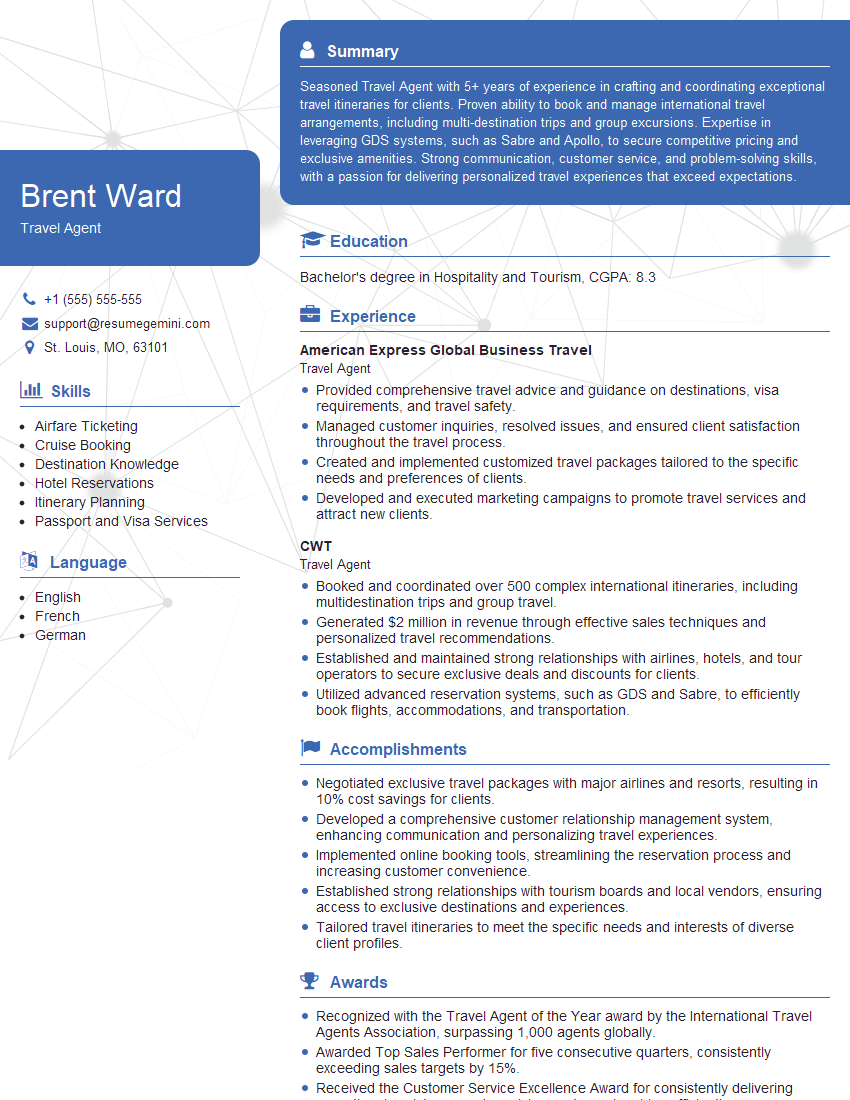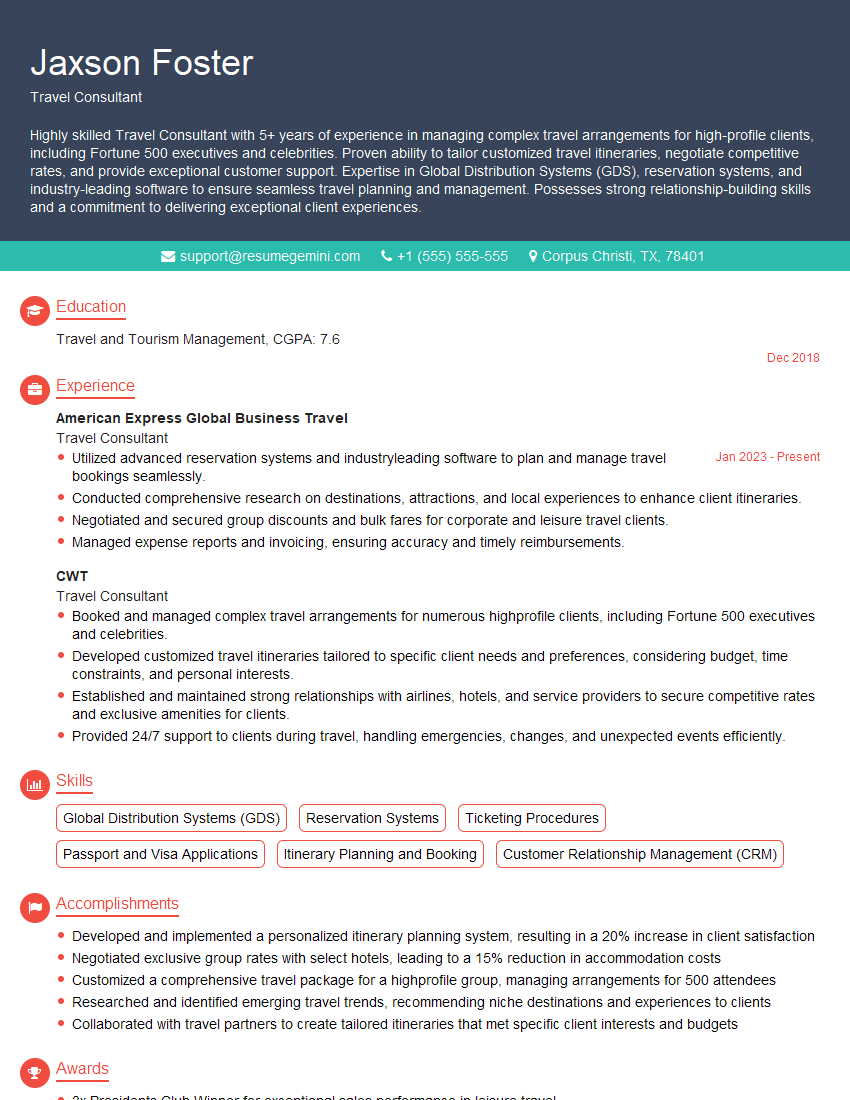Interviews are more than just a Q&A session—they’re a chance to prove your worth. This blog dives into essential Travel and Logistics interview questions and expert tips to help you align your answers with what hiring managers are looking for. Start preparing to shine!
Questions Asked in Travel and Logistics Interview
Q 1. Explain the difference between Incoterms 2020 and Incoterms 2010.
Incoterms, or International Commercial Terms, are a set of standardized trade terms published by the International Chamber of Commerce (ICC). They define the responsibilities of buyers and sellers in international trade transactions, specifically regarding delivery and risk transfer. Incoterms 2020, the latest version, clarifies several ambiguities and updates provisions to reflect modern trading practices compared to its predecessor, Incoterms 2010. Key differences include:
Clarification on ‘Carrier’ vs. ‘Vessel’: Incoterms 2020 distinguishes more clearly between ‘carrier’ (which can be any mode of transport) and ‘vessel’ (specifically for sea transport). This avoids confusion in selecting the appropriate Incoterm.
DAT (Delivered at Terminal) replaced by DPU (Delivered at Place Unloaded): DPU provides more flexibility as it doesn’t specify the exact location (like a specific terminal), allowing for greater adaptability to different delivery points, regardless of the mode of transport.
FCA (Free Carrier) modifications: Incoterms 2020 clarifies the responsibilities of the seller concerning handing over goods to the carrier at a specified location, addressing past ambiguity.
Increased focus on security: While not explicitly stated as a new rule, Incoterms 2020 implicitly encourages greater consideration for security aspects throughout the delivery process, given global security concerns.
For example, using DPU instead of DAT in Incoterms 2020 offers more flexibility for delivering goods to an inland container depot (ICD) or a warehouse, simplifying logistics and potentially reducing costs compared to the previous version. Choosing the correct Incoterm is crucial as it directly impacts who bears the cost and risk of transportation and insurance at different stages.
Q 2. Describe your experience with various transportation modes (air, sea, rail, road).
My experience spans all major transportation modes. I’ve worked extensively with:
Air Freight: I’ve managed time-sensitive shipments of high-value goods, like pharmaceuticals or electronics, utilizing air freight’s speed and reliability. This often involves coordinating with multiple airlines, handling customs documentation, and tracking shipments in real-time. For instance, I once expedited a shipment of medical equipment to a disaster-stricken area, utilizing chartered flights for faster delivery.
Sea Freight: I have significant expertise in ocean freight, managing both full container load (FCL) and less than container load (LCL) shipments for larger volumes of less time-sensitive goods. This involved negotiating favorable freight rates, optimizing container packing, and managing potential delays due to weather or port congestion. A key project involved optimizing sea freight for a client exporting furniture, resulting in a 15% reduction in transportation costs.
Rail Freight: I’ve leveraged rail transport for cost-effective long-distance movement of bulk goods and heavy machinery. This required coordinating with rail operators, ensuring proper loading and securing of cargo, and integrating rail transport with other modes like trucking for last-mile delivery. Successfully implementing a rail-truck intermodal solution for a construction materials supplier saved them significant fuel costs.
Road Freight: Road transport is integral to last-mile delivery and smaller shipments. I’ve managed trucking operations, optimized routes using route planning software, and monitored driver performance to ensure timely deliveries. Successfully implemented a route optimization strategy that reduced delivery times by 10% for a regional distributor.
Understanding the strengths and weaknesses of each mode, and skillfully integrating them, is crucial for optimizing the entire supply chain.
Q 3. How do you handle unexpected delays in the supply chain?
Unexpected delays are inevitable in logistics. My approach involves a multi-pronged strategy:
Proactive Risk Assessment: Identifying potential bottlenecks (weather, port congestion, political instability) beforehand allows for contingency planning.
Real-time Tracking and Monitoring: Utilizing advanced tracking systems enables early detection of delays and facilitates prompt response. For example, if a vessel experiences mechanical failure, immediate action can be taken to find alternative transport or reroute the shipment.
Communication and Collaboration: Open communication with clients, suppliers, and carriers is critical. Transparency helps manage expectations and maintain relationships during disruptions.
Contingency Planning: Having backup plans ready – alternative transportation modes, suppliers, or routes – ensures business continuity.
Root Cause Analysis: Once the delay is resolved, analyzing the cause helps prevent similar issues in the future. For example, a recurring delay due to customs clearance might necessitate a review of documentation procedures.
For example, when a major port strike threatened a crucial shipment, we immediately rerouted the goods through an alternative port, incurring additional costs, but preventing a significant delay and maintaining client satisfaction. Post-incident analysis allowed us to implement measures mitigating such risks in the future.
Q 4. What strategies do you use to optimize logistics costs?
Optimizing logistics costs requires a holistic approach:
Negotiating favorable rates: Building strong relationships with carriers and leveraging volume discounts helps secure competitive rates.
Route Optimization: Using route planning software and considering factors like traffic, fuel prices, and tolls minimizes transportation costs. We once implemented a dynamic routing system resulting in an 8% reduction in fuel expenses.
Efficient Warehouse Management: Minimizing warehouse space, optimizing storage strategies, and improving order fulfillment processes can reduce storage and handling costs.
Inventory Management: Reducing excess inventory minimizes storage costs and reduces the risk of obsolescence. Implementing Just-in-Time (JIT) inventory strategies can significantly lower holding costs.
Consolidation of Shipments: Combining smaller shipments into larger ones reduces per-unit transportation costs. A successful example involved consolidating shipments for a client distributing cosmetics, resulting in a 12% cost reduction.
Technology Implementation: Using Transportation Management Systems (TMS) and Warehouse Management Systems (WMS) streamlines operations, improving efficiency and reducing manual errors.
It’s crucial to consider all aspects of the supply chain, seeking efficiencies without compromising service levels.
Q 5. Explain your understanding of Lean principles in logistics.
Lean principles, focused on eliminating waste and maximizing value, are essential for efficient logistics. In logistics, ‘waste’ encompasses anything that doesn’t add value to the customer. Key Lean principles applied to logistics include:
Value Stream Mapping: Visualizing the entire logistics process to identify bottlenecks and areas for improvement. This helps pinpoint non-value-added activities.
5S Methodology (Sort, Set in Order, Shine, Standardize, Sustain): Creating a structured and organized warehouse and transportation process minimizes waste and improves efficiency.
Kaizen (Continuous Improvement): Constantly seeking small, incremental improvements in all aspects of the logistics process. Small changes can cumulatively result in significant improvements.
Just-in-Time (JIT) Inventory: Minimizing inventory holding costs by receiving materials only when needed. This reduces storage space requirements and minimizes risk of obsolescence.
Pull System: Production and logistics are driven by actual customer demand rather than forecasts. This reduces the risk of overproduction and waste.
For example, implementing a Kanban system (a visual signaling system) in a warehouse can optimize material flow and reduce unnecessary inventory. Lean principles are not just about cost reduction; they improve efficiency, speed, and quality, ultimately enhancing customer satisfaction.
Q 6. How do you manage inventory levels effectively?
Effective inventory management balances supply and demand to minimize holding costs while ensuring product availability. My approach involves:
Demand Forecasting: Accurately predicting future demand using historical data, market trends, and seasonality helps optimize inventory levels. We use statistical forecasting models and incorporate qualitative factors for greater accuracy.
Inventory Control Systems: Implementing robust inventory tracking systems, often integrated with WMS, provides real-time visibility into stock levels and helps avoid stockouts or overstocking. We regularly review accuracy and make adjustments as needed.
ABC Analysis: Classifying inventory into A (high-value), B (medium-value), and C (low-value) items allows for targeted inventory management strategies. A items require closer monitoring and tighter controls than C items.
Safety Stock: Maintaining a buffer stock to account for unexpected fluctuations in demand or supply chain disruptions is essential. The optimal safety stock level is determined based on demand variability and lead times.
Inventory Turnover Ratio: Regularly monitoring this key performance indicator (KPI) helps identify areas for improvement and optimize inventory management practices.
For instance, by implementing an ABC analysis, we prioritized inventory control for high-value items, reducing potential losses due to theft or damage.
Q 7. Describe your experience with Warehouse Management Systems (WMS).
I have extensive experience with Warehouse Management Systems (WMS), having implemented and managed several systems across different warehouse environments. WMS significantly improves warehouse efficiency by automating tasks such as:
Inventory Tracking: Real-time tracking of inventory levels, location, and movement within the warehouse.
Order Fulfillment: Optimizing picking, packing, and shipping processes to improve speed and accuracy.
Warehouse Layout Optimization: Designing efficient warehouse layouts based on product flow and storage requirements.
Labor Management: Tracking employee performance and optimizing workforce allocation to maximize efficiency.
Reporting and Analytics: Providing key performance indicators (KPIs) to monitor warehouse performance and identify areas for improvement.
I’ve worked with various WMS platforms, including Manhattan Associates WMS and Blue Yonder, adapting the system’s functionalities to fit specific warehouse needs. For example, I customized a WMS to integrate with our client’s e-commerce platform, enabling seamless order fulfillment and real-time inventory updates for online sales. The implementation resulted in a 20% increase in order fulfillment speed and a reduction in errors.
Q 8. How do you ensure compliance with international trade regulations?
Ensuring compliance with international trade regulations is paramount in global logistics. It involves understanding and adhering to a complex web of rules and regulations governing customs, tariffs, import/export restrictions, and trade agreements. This necessitates a multi-faceted approach.
In-depth knowledge of regulations: My expertise includes staying updated on the ever-evolving regulations specific to the countries and goods involved. This includes understanding things like Harmonized System (HS) codes for proper product classification, rules of origin, and any applicable sanctions or embargoes.
Documentation precision: Accurate and complete documentation is crucial. This involves meticulously preparing all necessary paperwork, including commercial invoices, packing lists, certificates of origin, and any required permits or licenses. A single error can lead to significant delays or penalties.
Partnering with customs brokers: I leverage the expertise of customs brokers to navigate the complexities of customs clearance in different countries. They act as intermediaries, ensuring all documentation is in order and processes are handled smoothly.
Internal compliance program: Implementing and maintaining a robust internal compliance program is essential. This includes regular training for staff on trade regulations, internal audits to identify potential compliance gaps, and a clear process for handling non-compliance issues.
Technology utilization: Employing software solutions that automate aspects of customs declarations and documentation ensures accuracy and reduces manual errors, further minimizing the risk of non-compliance. For example, utilizing a TMS with integrated customs functionality streamlines this process significantly.
For instance, when shipping electronics to the EU, I would ensure compliance with RoHS (Restriction of Hazardous Substances) directives and CE marking requirements. Failure to comply could result in product seizure or hefty fines.
Q 9. What metrics do you use to measure logistics performance?
Measuring logistics performance requires a balanced scorecard approach, using both qualitative and quantitative metrics. Key performance indicators (KPIs) are crucial for continuous improvement and accountability.
On-time delivery rate (OTDR): This measures the percentage of shipments delivered on or before the scheduled delivery date. A high OTDR signifies efficiency and reliability.
Order fulfillment cycle time: This measures the time taken from order placement to delivery, encompassing order processing, picking, packing, and shipping. Shorter cycle times indicate faster and more efficient operations.
Inventory turnover rate: This indicates how efficiently inventory is managed. A higher turnover rate suggests effective inventory management, reducing storage costs and minimizing obsolescence.
Freight cost per unit: This metric tracks the cost of transporting goods per unit, allowing for cost optimization strategies. Reducing this cost improves profitability.
Perfect order rate: This comprehensive KPI considers on-time delivery, complete orders, accurate invoicing, and undamaged goods. A high perfect order rate demonstrates superior overall performance.
Customer satisfaction: While subjective, gathering feedback through surveys or reviews provides valuable insights into customer experience and helps identify areas for improvement.
For example, consistently tracking OTDR allows for identifying bottlenecks in the supply chain, like port congestion or carrier delays, and proactively address those issues.
Q 10. Explain your experience with Transportation Management Systems (TMS).
My experience with Transportation Management Systems (TMS) is extensive. TMS software significantly streamlines logistics operations by automating tasks, optimizing routes, and providing real-time visibility into shipments. I’ve used various TMS solutions, both cloud-based and on-premise.
Route optimization: TMS software allows me to optimize delivery routes based on factors like distance, traffic patterns, and delivery windows, minimizing transportation costs and delivery times. This is especially useful for managing large fleets or complex delivery networks.
Shipment tracking and visibility: Real-time tracking capabilities provide up-to-the-minute information on the location and status of shipments, enabling proactive issue resolution and improved customer communication. This significantly enhances transparency and accountability.
Carrier management: TMS systems facilitate efficient carrier selection and management. This includes comparing rates, negotiating contracts, and managing communications with various carriers.
Warehouse management integration: Some advanced TMS platforms integrate with Warehouse Management Systems (WMS), providing end-to-end visibility from warehouse to delivery. This seamless integration streamlines the entire supply chain process.
Reporting and analytics: TMS solutions provide comprehensive reporting and analytics, offering valuable insights into logistics performance, cost analysis, and areas for improvement. This data-driven approach allows for informed decision-making.
In a previous role, implementing a new TMS resulted in a 15% reduction in transportation costs and a 10% improvement in on-time delivery rates within six months.
Q 11. How do you prioritize shipments based on urgency and importance?
Prioritizing shipments involves a systematic approach, considering both urgency and importance. A common method is using a matrix system.
Urgency: This refers to the time sensitivity of the shipment – how quickly it needs to be delivered. Examples include perishable goods, time-critical medical supplies, or urgent repair parts.
Importance: This considers the value or strategic significance of the shipment. High-value goods, crucial components for production, or shipments with significant contractual implications are considered high importance.
Prioritization Matrix:
A simple matrix can be used where urgency and importance are the axes. High urgency and high importance shipments are top priority, while low urgency and low importance shipments are lowest priority. This allows for clear prioritization and resource allocation.
Example Matrix:
| High Importance | Low Importance | |
|---|---|---|
| High Urgency | Top Priority | Medium Priority |
| Low Urgency | Medium Priority | Low Priority |
Beyond the matrix, factors like customer relationships and potential penalties for late delivery also influence prioritization decisions.
Q 12. Describe your experience with risk management in logistics.
Risk management in logistics is crucial for mitigating potential disruptions and ensuring business continuity. It’s a proactive process that anticipates, assesses, and manages potential threats.
Risk identification: This involves systematically identifying potential risks across the entire supply chain, including natural disasters, geopolitical instability, supplier failures, transportation delays, and security breaches. Techniques like SWOT analysis and brainstorming sessions can be used.
Risk assessment: Once risks are identified, their likelihood and potential impact need to be assessed. This allows for prioritizing risks based on their severity.
Risk mitigation strategies: Developing and implementing strategies to reduce the likelihood or impact of identified risks is critical. This might include diversifying suppliers, using multiple transportation modes, employing robust security measures, and having contingency plans in place.
Monitoring and review: Regularly monitoring the effectiveness of risk mitigation strategies and adapting them as necessary is vital. Supply chain dynamics change, requiring ongoing evaluation and adjustments.
Insurance and contracts: Utilizing appropriate insurance coverage and negotiating robust contracts with suppliers and carriers transfer some of the risk, providing financial protection against potential losses.
For instance, during a pandemic, our risk management plan included securing alternative suppliers, establishing buffer stock levels, and closely monitoring carrier availability to avoid disruptions.
Q 13. How do you manage relationships with suppliers and carriers?
Managing relationships with suppliers and carriers is crucial for the smooth operation of the supply chain. This involves a collaborative approach built on trust, communication, and mutual benefit.
Strategic partnerships: Developing strong, long-term relationships with key suppliers and carriers fosters collaboration and loyalty. This reduces reliance on single sources, minimizes risk, and often leads to better pricing and service.
Clear communication: Maintaining open and transparent communication is essential. This involves sharing information promptly, addressing concerns proactively, and establishing clear expectations regarding service levels and performance metrics.
Performance evaluation: Regularly evaluating the performance of suppliers and carriers based on pre-defined KPIs helps identify areas for improvement and ensures accountability. This includes tracking on-time delivery, quality of service, and responsiveness.
Negotiation and contract management: Negotiating favorable contracts that align with business needs is crucial. This includes clear terms and conditions, service level agreements (SLAs), and dispute resolution mechanisms.
Relationship management tools: Using technology like CRM systems to track interactions, maintain records, and facilitate communication improves efficiency and strengthens relationships.
For example, I’ve worked closely with a key carrier to implement a just-in-time delivery system, resulting in significant cost savings and improved inventory management.
Q 14. What software and tools are you proficient in using for logistics management?
My proficiency in logistics management software and tools is extensive. This includes various TMS platforms (like Oracle Transportation Management, SAP Transportation Management), WMS (like Manhattan Associates, Blue Yonder), and other specialized software.
Transportation Management Systems (TMS): As mentioned, I have hands-on experience with several leading TMS solutions, leveraging their features for route optimization, shipment tracking, carrier management, and reporting.
Warehouse Management Systems (WMS): Experience with WMS software aids in managing warehouse operations, inventory control, order fulfillment, and warehouse space optimization.
Enterprise Resource Planning (ERP) systems: Familiarity with ERP systems (e.g., SAP, Oracle) is crucial for integrating logistics data with other business functions, facilitating seamless flow of information.
Geographic Information Systems (GIS): GIS tools are useful for visualizing supply chain networks, analyzing geographical data, and optimizing logistics routes.
Data analytics tools: Proficiency in data analytics tools like Tableau or Power BI allows me to extract insights from logistics data, identify trends, and support data-driven decision-making.
Microsoft Office Suite: Proficiency in Excel, Word, and PowerPoint is fundamental for documentation, reporting, and communication.
Beyond software, I’m also skilled in utilizing various communication platforms for collaboration and coordination with suppliers, carriers, and internal teams.
Q 15. How do you handle customer complaints related to logistics?
Handling customer complaints related to logistics requires a structured and empathetic approach. My process begins with active listening to understand the customer’s issue fully. This involves clarifying details about the shipment, its status, and the specific problem encountered. I then categorize the complaint – is it a delay, damage, loss, or a billing discrepancy? This categorization helps determine the appropriate response and escalation path.
For minor issues like tracking updates, I provide prompt and accurate information directly. For more significant problems such as damaged goods, I initiate a claim process, gathering necessary documentation like photos and delivery receipts. This often involves coordinating with the carrier, insurance provider, and the customer to resolve the matter fairly and efficiently. Transparent communication throughout the process is key – keeping the customer informed of every step taken and estimated resolution timelines. Ultimately, my goal is to find a solution that satisfies the customer and minimizes any negative impact on their business.
For example, I once handled a complaint about a delayed shipment of perishable goods. By working directly with the carrier, I identified a logistical bottleneck at a specific transit hub. By proactively contacting the hub and prioritizing the shipment, I managed to expedite its delivery, minimizing spoilage and ensuring customer satisfaction. The key was combining problem-solving skills with clear, empathetic communication.
Career Expert Tips:
- Ace those interviews! Prepare effectively by reviewing the Top 50 Most Common Interview Questions on ResumeGemini.
- Navigate your job search with confidence! Explore a wide range of Career Tips on ResumeGemini. Learn about common challenges and recommendations to overcome them.
- Craft the perfect resume! Master the Art of Resume Writing with ResumeGemini’s guide. Showcase your unique qualifications and achievements effectively.
- Don’t miss out on holiday savings! Build your dream resume with ResumeGemini’s ATS optimized templates.
Q 16. Describe your experience with customs brokerage and documentation.
Customs brokerage and documentation are critical aspects of international shipping. My experience encompasses preparing and submitting all necessary documentation for various customs authorities globally. This includes commercial invoices, packing lists, certificates of origin, and other regulatory documents required for specific goods and destinations. I am proficient in navigating the complexities of import and export regulations, ensuring compliance with all applicable laws and minimizing potential delays or penalties.
I have extensive experience with the use of various customs brokerage software systems to streamline the process, from creating entry filings to managing bond accounts and tracking shipment status. Understanding the nuances of harmonized tariff codes (HS codes) is crucial for accurate classification and duty calculation. Incorrect classification can lead to costly delays and penalties. Therefore, I meticulously verify the HS codes for each shipment, ensuring accuracy and minimizing potential risks.
For instance, I recently navigated the complex import regulations for a client shipping specialized medical equipment to Japan. This required meticulous preparation of documentation, including specific certifications needed to comply with Japanese regulatory standards. My understanding of these regulations and my ability to accurately prepare all the required documentation led to a smooth and efficient import process, avoiding potential delays and ensuring timely delivery of the critical medical equipment.
Q 17. How do you ensure the security and safety of shipments?
Ensuring shipment security and safety is paramount. My approach involves a multi-layered strategy that begins with proper packaging and handling. Fragile items are appropriately protected, and hazardous materials are handled according to strict regulations. We utilize secure warehousing facilities with controlled access and surveillance systems to protect goods during storage.
For in-transit security, I leverage carrier partnerships with strong security protocols, including GPS tracking, sealed containers, and security escorts for high-value shipments. We also utilize various risk mitigation strategies, such as cargo insurance, which covers potential losses or damages during transit. Regular audits of our security procedures are conducted to ensure their effectiveness and to identify any potential weaknesses that need addressing.
In one instance, we had a shipment of high-value electronics. To mitigate the risk of theft, we implemented a multi-layered security approach including GPS tracking, sealed containers, and insurance coverage. We even coordinated with the carrier to ensure the shipment was transported during daylight hours and avoided routes known for higher crime rates. This proactive approach resulted in the safe and timely delivery of the shipment, minimizing the risk of loss or damage.
Q 18. Explain your understanding of different freight classifications.
Freight classification is crucial for determining transportation costs, handling procedures, and regulatory compliance. Different classifications categorize goods based on factors like size, weight, density, fragility, and hazardous nature. Understanding these classifications is essential for optimizing shipping costs and ensuring safe and efficient transport.
Key classifications include:
- Dimensional Weight (DIM): Considers the volume of the shipment alongside its actual weight. Larger, less dense items may be charged based on their dimensional weight, which is often higher than their actual weight.
- Hazardous Materials (HazMat): Requires specialized handling, packaging, and documentation due to potential risks to safety and the environment. Specific regulations and permits are needed for shipping hazardous materials.
- Oversized/Heavyweight Cargo: Requires special handling and transportation due to their size and weight, often involving specialized equipment like flatbed trucks or heavy-lift cranes.
- Temperature-Sensitive Goods: Need temperature-controlled transportation to maintain their quality and prevent spoilage or damage. This often involves refrigerated trucks or containers.
Accurate classification minimizes discrepancies and unexpected costs. For example, misclassifying a shipment as non-hazardous when it contains hazardous materials can lead to severe penalties and delays. Conversely, correct classification allows for selecting the most cost-effective transportation mode and minimizing handling risks.
Q 19. How do you use data analytics to improve logistics processes?
Data analytics plays a vital role in optimizing logistics processes. By analyzing data from various sources – including transportation management systems (TMS), warehouse management systems (WMS), and customer relationship management (CRM) systems – we identify trends, patterns, and inefficiencies. This data-driven approach enables informed decision-making and continuous improvement.
For example, we can use data analytics to:
- Optimize Routing: Analyzing historical shipment data allows for identifying the most efficient routes, reducing transportation time and fuel costs.
- Improve Warehouse Efficiency: Analyzing inventory levels, storage space utilization, and order fulfillment times helps optimize warehouse operations and reduce costs.
- Predict Demand: Forecasting future demand based on historical sales data and market trends enables better inventory management and reduces stockouts or excess inventory.
- Enhance Customer Service: Analyzing customer feedback and shipment tracking data helps identify areas for improvement in customer service and on-time delivery performance.
We use tools like regression analysis and forecasting models to predict future demand, and machine learning algorithms to optimize routes and warehouse operations. The result is a more efficient and cost-effective logistics operation, with improved customer satisfaction.
Q 20. Describe your experience with forecasting demand in supply chain management.
Forecasting demand in supply chain management is crucial for efficient inventory management and resource allocation. My approach involves a combination of quantitative and qualitative methods, leveraging historical sales data, market trends, and expert insights to develop accurate forecasts. I utilize various forecasting techniques, including time series analysis, exponential smoothing, and ARIMA models.
Historical sales data provides a baseline for predicting future demand. However, external factors like seasonality, economic conditions, and promotional activities also significantly impact demand. Therefore, I incorporate these factors into my forecasting models, adjusting them based on market intelligence and expert opinions from sales and marketing teams. For instance, if a new competitor enters the market, I would adjust my forecast to reflect potential changes in market share.
For a specific example, I once worked with a retail client to forecast holiday season demand for their products. By analyzing previous years’ sales data, factoring in expected promotional activities, and considering economic indicators, I developed a detailed demand forecast. This allowed the client to optimize inventory levels, ensure sufficient stock to meet demand during the peak season, and avoid stockouts or excess inventory. The accuracy of my forecast minimized storage costs and ensured high product availability during a crucial sales period.
Q 21. How do you handle capacity planning in a dynamic environment?
Capacity planning in a dynamic environment requires flexibility and adaptability. My strategy involves combining long-term strategic planning with short-term tactical adjustments. I start with analyzing historical capacity utilization data, identifying peak demand periods, and forecasting future growth. This long-term planning helps establish a baseline capacity level, considering factors such as warehouse space, transportation fleet, and personnel.
However, unexpected events and market fluctuations require short-term adjustments. Real-time monitoring of key metrics – such as order volume, transportation lead times, and warehouse occupancy – is essential for identifying potential capacity constraints. To adapt to these fluctuations, I utilize various strategies, including:
- Flexible Staffing: Employing temporary staff during peak seasons or periods of high demand.
- Dynamic Routing: Optimizing transportation routes based on real-time traffic and availability.
- Outsourcing: Utilizing third-party logistics providers (3PLs) to supplement existing capacity during peak demand.
- Inventory Optimization: Using advanced inventory management techniques to optimize stock levels and minimize warehouse congestion.
For example, during a period of unexpectedly high demand, we utilized a combination of strategies. We temporarily increased our staffing levels, negotiated with a 3PL to handle overflow inventory, and dynamically optimized our transportation routes to ensure timely deliveries. This agile approach allowed us to handle the surge in demand without compromising service levels or incurring excessive costs.
Q 22. Explain your understanding of the concept of ‘just-in-time’ inventory.
Just-in-time (JIT) inventory is a management strategy that aims to receive goods only when needed for production or sale, minimizing storage costs and waste. Think of it like ordering ingredients for a restaurant only when you’re about to cook a dish – no unnecessary storage space for perishable items.
This approach relies heavily on accurate demand forecasting and efficient supply chain relationships. It reduces the risk of obsolescence (especially critical for products with short shelf lives or rapid technological advancements), minimizes warehousing costs (rent, utilities, insurance, etc.), and frees up capital that would otherwise be tied up in inventory.
For example, in the travel industry, a tour operator might utilize JIT for arranging transportation, only confirming bus rentals or flight bookings once a sufficient number of participants have registered for the tour. This reduces the risk of having empty seats or unsold transport slots.
- Benefits: Reduced storage costs, minimized waste, improved cash flow, increased efficiency.
- Challenges: Requires precise demand forecasting, reliance on reliable suppliers, vulnerability to supply chain disruptions.
Q 23. How do you ensure the traceability of goods throughout the supply chain?
Ensuring traceability of goods across the supply chain involves tracking items from origin to final destination. This is crucial for accountability, quality control, and recall management in case of defects or contamination. We achieve this through a combination of methods:
- Unique Identification: Each item or package receives a unique identifier (barcode, RFID tag, serial number). This allows us to track its journey.
- Technology Integration: We utilize various technologies, including barcode scanners, RFID readers, and GPS tracking systems, integrated with a centralized database. This data is usually entered into a comprehensive inventory management system.
- Data Management: Robust data management systems store, organize, and provide easy access to tracking information throughout the supply chain. Regular audits are performed to ensure the accuracy of this data.
- Collaboration: Effective communication and information sharing between all parties in the supply chain (suppliers, manufacturers, transporters, distributors, retailers) are essential for comprehensive traceability.
Imagine a travel agency selling a tour package involving flights, hotels, and excursions. Traceability systems can track the flight booking confirmation, the hotel reservation details, and the assigned transportation for each excursion, enabling easy retrieval of information for each customer’s itinerary and swift troubleshooting if any issues arise.
Q 24. Describe your experience with implementing new logistics technologies.
I have extensive experience in implementing new logistics technologies, including:
- Transportation Management Systems (TMS): Implemented a TMS to optimize routing, scheduling, and fleet management, leading to a 15% reduction in transportation costs and a 10% improvement in on-time delivery.
- Warehouse Management Systems (WMS): Successfully oversaw the implementation of a WMS in a large distribution center, automating inventory management, reducing order fulfillment time by 20%, and minimizing storage space usage.
- Blockchain Technology: Explored the potential of blockchain for enhancing supply chain transparency and security, enabling real-time tracking and improving product provenance verification. This is still in the trial stage but is showing early promise.
My approach focuses on thorough needs assessment, choosing the right technology for the task, ensuring seamless integration with existing systems, and providing comprehensive training to staff. Change management is a critical aspect, as is ensuring user buy-in throughout the process.
Q 25. How do you manage the environmental impact of logistics operations?
Managing the environmental impact of logistics operations is a key priority. We focus on several strategies:
- Route Optimization: Utilizing route optimization software to minimize fuel consumption and reduce carbon emissions. This involves factors like distance, traffic conditions, and delivery schedules.
- Fuel-Efficient Vehicles: Transitioning to more fuel-efficient vehicles, including hybrid and electric options, whenever feasible.
- Consolidation of Shipments: Optimizing shipment sizes to utilize full truckload capacity, reducing the number of vehicles on the road.
- Sustainable Packaging: Using recyclable and biodegradable packaging materials to minimize waste and reduce our environmental footprint.
- Carbon Offsetting: Investing in carbon offset projects to compensate for unavoidable emissions.
In the travel industry, this translates to encouraging eco-friendly transportation options (trains, electric buses) for tours, partnering with hotels that have sustainable practices, and reducing the use of single-use plastics in tour packages.
Q 26. How do you handle negotiations with carriers and suppliers?
Negotiating with carriers and suppliers requires a strategic and collaborative approach. My strategy involves:
- Building Relationships: Establishing strong, long-term relationships based on trust and mutual benefit. This often involves regular communication and transparency.
- Market Research: Thoroughly researching market rates and competitor offerings to ensure fair and competitive pricing.
- Data-Driven Negotiations: Utilizing data on past performance, volume projections, and market trends to support our negotiating positions.
- Value-Based Negotiation: Focusing on the overall value proposition, not just price alone. This includes factors like service quality, reliability, and responsiveness.
- Win-Win Outcomes: Striving for mutually beneficial agreements that ensure fair pricing for both parties while maintaining high service standards.
For example, when negotiating with a hotel chain for a tour package, I might leverage our consistent high booking volume to request a better rate or additional amenities for our clients, creating a mutually advantageous arrangement.
Q 27. Describe your experience with different types of warehousing solutions.
My experience encompasses various warehousing solutions, each suited for different needs:
- Public Warehousing: Utilizing third-party warehouses offers flexibility and scalability, especially beneficial for businesses with fluctuating inventory levels. This avoids the upfront investment in owning and maintaining warehouse space.
- Private Warehousing: Owning and operating private warehouses provides greater control and customization but demands significant capital investment and ongoing operational costs.
- Contract Warehousing: A hybrid approach where a third-party provider manages a warehouse facility tailored to a specific client’s needs. This offers a balance between control and cost-effectiveness.
- Automated Warehousing: Implementing automated systems (conveyors, robotic picking) improves efficiency and reduces labor costs but comes with high initial investment and potential integration complexities.
The selection depends on factors like inventory volume, product type, budget, required level of control, and proximity to transportation hubs. In the travel industry, a tour operator might use public warehousing to store promotional materials, while a larger company might invest in private warehousing to manage its inventory of tour-related equipment.
Q 28. How do you ensure compliance with safety regulations in transportation?
Ensuring compliance with safety regulations in transportation is paramount. Our approach includes:
- Driver Training and Certification: Requiring all drivers to undergo thorough training and obtain necessary certifications and licenses, adhering to all relevant regulations related to driver hours and safety protocols.
- Vehicle Maintenance and Inspections: Implementing a rigorous vehicle maintenance schedule and conducting regular inspections to ensure vehicles are in safe operating condition.
- Cargo Securement: Utilizing proper cargo securing techniques to prevent shifting or damage during transportation, ensuring the safety of the drivers and the public.
- Compliance Tracking: Regularly monitoring compliance with all relevant regulations, including speed limits, weight restrictions, and hazardous material handling procedures.
- Record Keeping: Maintaining detailed records of all safety-related activities, including inspections, maintenance, and training, for easy auditing.
For a travel company organizing bus tours, this means meticulously checking bus maintenance records, ensuring the driver possesses a valid commercial driver’s license (CDL), and strictly adhering to speed limits and passenger safety regulations.
Key Topics to Learn for Your Travel and Logistics Interview
- Supply Chain Management: Understand the flow of goods, from origin to destination, including inventory management, warehousing, and transportation modes. Consider practical applications like optimizing delivery routes or managing potential disruptions.
- Logistics Operations: Explore the day-to-day functions of logistics, including order fulfillment, transportation planning, and customer service. Think about how you would troubleshoot a delayed shipment or handle a customer complaint efficiently.
- International Trade and Regulations: Familiarize yourself with customs procedures, import/export regulations, and documentation requirements. Consider how you would navigate complex international shipping regulations.
- Transportation Modes and Technologies: Gain a solid understanding of various transportation methods (air, sea, rail, road) and relevant technologies like GPS tracking and route optimization software. Think about how technology improves efficiency and reduces costs.
- Risk Management and Mitigation: Learn about identifying and mitigating potential risks within the supply chain, such as weather delays, geopolitical instability, or security concerns. Consider how you would develop a contingency plan for unexpected events.
- Data Analysis and Reporting: Understand the use of data in logistics, including key performance indicators (KPIs) and reporting. Think about how you would analyze data to identify areas for improvement and make data-driven decisions.
- Warehouse Management Systems (WMS): Explore the functionality and importance of WMS in optimizing warehouse operations. Consider how WMS contributes to inventory accuracy and efficiency.
Next Steps
Mastering Travel and Logistics opens doors to a dynamic and rewarding career with excellent growth potential. To stand out, a strong and ATS-friendly resume is crucial. This is where ResumeGemini can help! ResumeGemini provides the tools and resources to create a professional resume that highlights your skills and experience effectively. We offer examples of resumes tailored specifically to the Travel and Logistics industry to give you a head start. Invest time in crafting a compelling resume – it’s your first impression and a key to unlocking your career aspirations.
Explore more articles
Users Rating of Our Blogs
Share Your Experience
We value your feedback! Please rate our content and share your thoughts (optional).
What Readers Say About Our Blog
Hello,
We found issues with your domain’s email setup that may be sending your messages to spam or blocking them completely. InboxShield Mini shows you how to fix it in minutes — no tech skills required.
Scan your domain now for details: https://inboxshield-mini.com/
— Adam @ InboxShield Mini
Reply STOP to unsubscribe
Hi, are you owner of interviewgemini.com? What if I told you I could help you find extra time in your schedule, reconnect with leads you didn’t even realize you missed, and bring in more “I want to work with you” conversations, without increasing your ad spend or hiring a full-time employee?
All with a flexible, budget-friendly service that could easily pay for itself. Sounds good?
Would it be nice to jump on a quick 10-minute call so I can show you exactly how we make this work?
Best,
Hapei
Marketing Director
Hey, I know you’re the owner of interviewgemini.com. I’ll be quick.
Fundraising for your business is tough and time-consuming. We make it easier by guaranteeing two private investor meetings each month, for six months. No demos, no pitch events – just direct introductions to active investors matched to your startup.
If youR17;re raising, this could help you build real momentum. Want me to send more info?
Hi, I represent an SEO company that specialises in getting you AI citations and higher rankings on Google. I’d like to offer you a 100% free SEO audit for your website. Would you be interested?
Hi, I represent an SEO company that specialises in getting you AI citations and higher rankings on Google. I’d like to offer you a 100% free SEO audit for your website. Would you be interested?
good





